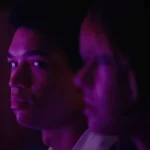Newtown: Old Wounds, by David Bax
Kim A. Snyder’s Newtown is by no means an easy sit, nor should it be. As a documentary portrait of the titular town upon which was visited one of the most horrific acts of violence in recent public memory, it’s wrenching and soul-draining. What it is not, thank God, is gawking or exploitative. If such suspicions creep into the early scenarios, be patient. Snyder is putting together a testament to the resilience and stability of community, a human construct in which we individuals of frail flesh gain strength through linked hearts.
Snyder embeds herself in Newtown, less than three years after the shooting for which the town’s name is now a synonym, and pieces together her mosaic by interviewing and spending time with an array of people. Most of them are parents of the children killed that day; some of them are teachers who lost both students and colleagues; some of them are janitors or parents of survivors or friends of the older siblings of the victims. Even if a connection is a few degrees away, it becomes clear that no one in Newtown was not touched by the shooting.
A close-knit, mostly Catholic community about a half hour outside of Bridgeport, CT, the Newtown depicted by Snyder reminded me deeply of Ballwin, the close-knit, mostly Catholic community about a half hour outside of St. Louis, MO where I grew up. There are particular details, such as one single priest presiding over almost every victim’s funeral, that are the result of this distinct identity. But there’s universality in the specific and, even if your hometown is superficially dissimilar, you’ll likely find the social relationships between neighbors, coworkers and family more than a little familiar.
Most of us, though, hope to never be familiar with the defining trait of Newtown’s identity, that as a site of inhuman suffering and shock. Events such as the school shooting that shook and gutted the town tend to be branded in our national memory along with dates. In this case, it’s December 14, 2012. What Snyder and the warm people of Newtown—broken but not destroyed—show us is that that Friday morning is, in many ways, still happening to them and always will be.
When the film comes to the political issue of gun control, as it must, Snyder has no interest in maintaining bias. Still, she is careful not to puncture the mission statement of her film as an account of people, not one of topics. What we see of the lobbying and activism comes exclusively through the film’s depiction of the parents who have devoted their time and passion to such causes over the past few years. When one of them says of the politicians who chose their special interest benefactors over the lives of children, “What’s a bigger line item in their job description than keeping their constituents safe?” The man who says that is not some hired expert. He’s a human, a citizen and a victim in his own right. This isn’t propaganda; it’s advocacy.
There has been a shameful, infuriating number of large scale, public shootings in our nation’s recent history, all of them inspiring rage, hopelessness and deep-seated grief. Newtown, though, created shockwaves that are less common and more powerful because so many of the dead were young children, first graders. You don’t have to be a kid or have a kid for that to hit home. We, as human beings, tend to see the best of ourselves in children. We see happiness unspoiled, our own unfulfilled potential, all the mistakes we never made. Newtown brings us all back to that day and reminds us that when those children died, pieces of all of us died as well.




























